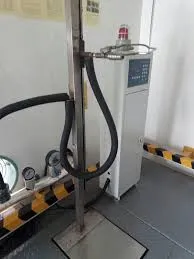335345435
Jul . 27, 2024 07:13 Back to list
How to Safely Disconnect and Remove a Hydraulic Hose for Maintenance and Repair
Understanding the Importance of Disconnecting Hydraulic Hoses Safely
Hydraulic systems are integral to many industries, powering equipment that facilitates a range of heavy-duty operations. From construction machinery to agricultural equipment, hydraulic systems use pressurized fluid to perform work. However, with great power comes significant responsibility, particularly when it comes to the maintenance and servicing of these systems. A critical aspect of hydraulic system maintenance is the safe disconnection of hydraulic hoses.
Disconnecting hydraulic hoses is often necessary for various reasons, including repairs, replacements, or inspections. However, this process must be approached with caution to avoid accidents and ensure the efficient operation of the machinery once reconnected. Here are some essential guidelines and considerations for safely disconnecting hydraulic hoses.
Understanding the Risks
Before attempting to disconnect hydraulic hoses, it’s crucial to understand the potential hazards involved. Hydraulic systems operate under high pressure, often exceeding several thousand psi. If a hose is disconnected improperly, it can lead to a sudden release of fluid, which can not only damage the equipment but can also pose serious safety risks to personnel nearby. Hydraulic fluid can be very harmful; it can cause burns, environmental contamination, and even create slip hazards if not managed appropriately.
Preparation is Key
Prior to disconnecting a hydraulic hose, thorough preparation is essential. First, ensure that you are wearing the appropriate personal protective equipment (PPE). This may include safety goggles, gloves, and protective clothing to safeguard against potential fluid sprays or leaks.
Secondly, consult the equipment's manual. Different machinery may have unique protocols for disconnecting hoses. Familiarity with the equipment will help you follow the manufacturer’s instructions accurately and avoid unintended consequences.
disconnect hydraulic hose

Depressurizing the System
Before disconnecting any hoses, always ensure that the hydraulic system is depressurized. This is one of the most critical steps in the disconnection process. To do this, shut off the machinery and allow it to cool down, if necessary. Locate the release valve on the hydraulic system and carefully open it to allow any remaining pressure to dissipate. It’s advisable to stand at a safe distance while performing this step to minimize the risk of accidental fluid discharge.
Disconnecting the Hoses
Once the system is depressurized, you can proceed to disconnect the hydraulic hoses. Start by identifying the appropriate fittings and use the correct tools for the job. Typically, hydraulic hoses are secured using either a threaded connection, quick-disconnect coupling, or clamps.
If you are dealing with threaded connections, ensure that you turn them slowly and steadily to avoid stripping the threads. For quick-disconnect couplings, make sure to follow the specific release mechanism designed for that connector. It’s critical to grip the hose firmly and avoid pulling on it directly, which could damage the fitting or the hose itself.
Cleaning and Inspecting
After the hoses have been safely disconnected, take the opportunity to inspect both the hoses and the fittings for any signs of wear or damage. Cleaning the connection points can also help prevent contamination of the hydraulic fluid when reconnecting.
Ultimately, disconnecting hydraulic hoses is a process that requires knowledge, caution, and adherence to safety protocols. By understanding the risks, preparing adequately, and following the appropriate steps, operators can ensure that their hydraulic systems remain safe and efficient, minimizing the potential for accidents and equipment failure in industrial settings.
-
SAE 100 R17 Black Smooth Cover Hydraulic Hose
NewsMar.07,2025
-
SAE 100 R17 Black Smooth Cover Hydraulic Hose
NewsMar.07,2025
-
SAE 100 R17 Black Smooth Cover Hydraulic Hose
NewsMar.07,2025
-
SAE 100 R17 Black Smooth Cover Hydraulic Hose
NewsMar.07,2025
-
SAE 100 R17 Black Smooth Cover Hydraulic Hose
NewsMar.07,2025
-
steel wire braided hydraulic hose
NewsMar.07,2025



